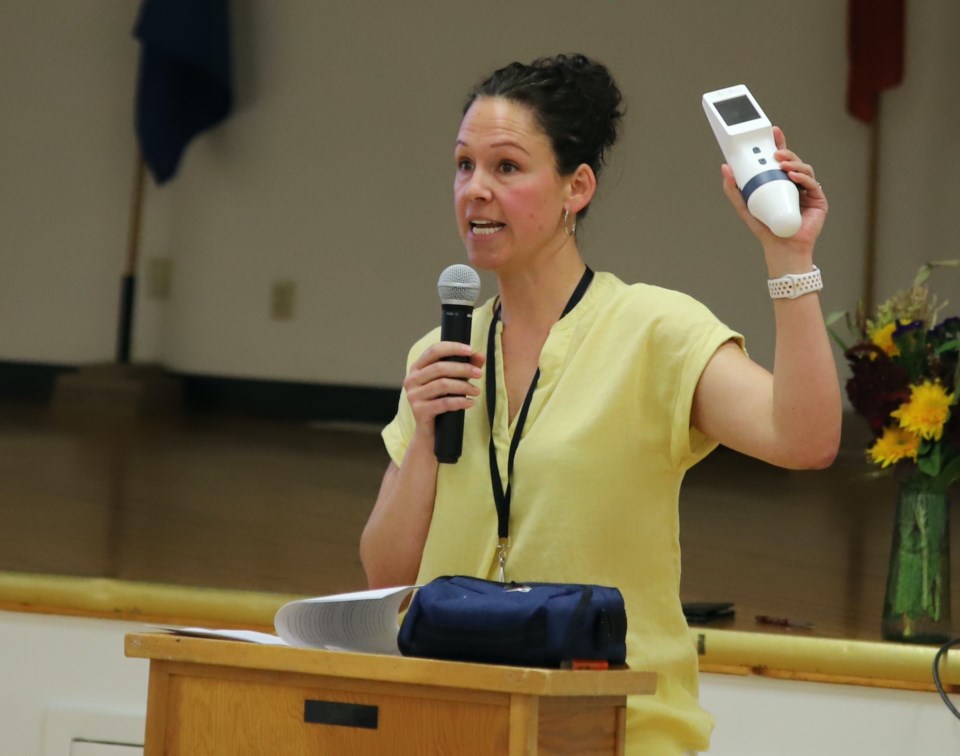OLDS — Three pieces of equipment funded by the Olds Health Care Fundraising Committee might seem simple or minor, but they’ve made a big difference for clients and caregivers.
Brandy Antle, Home Care manager for Olds and Sundre, made that assertion during a brunch organized by the Olds Health Care Fundraising Committee (OHCFC), held Oct. 6 at the Evergreen Centre.
Those three items are a treatment bed, clinic light and a portable bladder scanner.
Treatment bed
“At first glance, you might not think a treatment table could make that much of a difference, but it does,” Antle said.
“In a community setting, where space can be limited and health care workers need to make the most of the available equipment, a good treatment bed is essential.
“A high-quality, adjustable treatment bed offers both comfort for the clients and ergonomic benefits for the health care provider.”
Antle said the bed is especially helpful for those with mobility issues or chronic pain.
“Being positioned properly during care and treatment can make a significant difference in the overall experience and outcomes,” she said.
“Whether it’s for wound care, IV therapy or general exams, the right bed helps clients feel secure and comfortable, which in turn fosters a more positive health care experience.”
Antle said the fact that the bed can be adjusted to the right, convenient height also makes a big difference for health care providers.
“Health care professionals often face a high risk of back problems, due to frequent lifting and bending,” she said.
“A proper treatment bed eliminates many of these risks, making the job safer and allowing care staff to focus more directly on client care, than managing their own discomfort.
“This is especially important in community settings where health care providers are often asked to deliver a wide variety of services and sometimes with limited assistance.”
Clinic light
“In a community clinic or a home health setting where lighting conditions may not be optimal, a clinic light provides necessary brightness and focus for precision care,” Antle said.
“Whether it’s for wound care, dressing changes, IV start, good lighting ensures that health care professionals can see clearly, which is essential for making accurate diagnosis and performing procedures safely.
“Poor lighting does increase the risk of error which can lead to infections, misdiagnosis or treatment delays.
“It’s not just about having bright light. It’s about having focused, adjustable lighting that allows for safer and more effective care.”
Bladder scanner
Antle described the bladder scanner as a non-invasive “game changer in assessing bladder function.”
The hand-held device, about the size of a walkie-talkie, uses ultrasound to give real-time imaging of the bladder and it measures the volume of urine retained, right in the client’s own home or a clinic.
“Traditionally, when someone experiences urinary retention or incontinence, invasive procedures like catheterization are often used to diagnose the issue.
“Not only is this uncomfortable for clients, but (it) also increases the risk of urinary tract infection and other complications,” she said, adding it’s especially useful in rural areas, where access to hospital-grade equipment or specialists is limited.
“The uniqueness of it and the appreciation of it is its portability,” she said. “Nurses have a lot of things to take into people’s homes with them as it is. So having this portable device, it’s a point and click.”
“We’re able to go into people’s homes and instead of putting in a urinary catheter, we have a diagnostic tool that we can work with the family physician or the specialist to create a care plan that is minimally invasive,” she said.
Antle summed up the advantages of the three pieces of equipment.
“In rural areas, health care providers face a unique set of challenges,” she said.
“So ultimately, these pieces of equipment are not just about improving the clinical side of health care, they’re about improving quality of life for the members of our community.
“By making health care more accessible, reducing discomfort, preventing complications, we are helping people live healthier, more comfortable lives.
“This is particularly important for seniors, individuals with chronic conditions and people living in rural communities who may not have access to a full range of health care services.”
“The bladder scanner, treatment bed and clinic light might seem like simple tools, but their benefits are profound.
“They are helping make high-quality, client-centred care into the community, making a tangible difference in the life of clients, caregivers, and health care providers.
“By investing in these types of tools, we are investing in better health care for all of us.”



